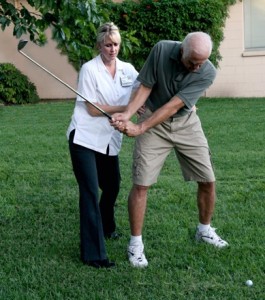
You don't have to be Tiger Woods to suffer an ACL tear. Fortunately, you can receive Tiger Woods-like medical treatment to get you back on the links.
Unlike being diagnosed with four clogged arteries after suffering a heart attack, which requires immediate medical intervention, an injury to your ACL gives you both time and options. “An ACL deficient knee is not a medical emergency,” said Rick Rossman, MS, PT, Administrative Director of Pomona Valley Hospital Medical Center’s Sports Medicine Center.
All too often a generation ago, people who injured their ACLs learned to live with what was then referred to as a trick or bum knee. It meant that if you moved wrong, your knee would buckle, but if you literally watched your step, staying on the straight and narrow, you could get by.
Getting by might be acceptable if you’re no longer playing competitive sports, but for the young athlete, the option might be unacceptable. Plus, Rossman noted that numerous studies have shown that an unrepaired ACL leads to early arthritis. “Long-term follow-up studies that followed ACL reconstruction patients for 15 years after their surgery unfortunately showed the knee still becomes arthritic” Rossman said. “But, it probably won’t occur as quickly or as dramatically.
Collateral Damage
“Often when the ACL is torn,” Rossman continued, “you have collateral damage. Injuries are common to both the meniscus (two ‘C’-shaped washers that sit between the end of the thigh and the shin bone) and to the hard articular cartilage (covers the end of the two knee bones). Other ligaments can be stretched or torn as well.” All result in wobbling, instability and wear and tear over time that accelerates the onset of arthritis in the joint.
To help patients visualize their injury and treatment choices better, Rossman uses the analogy of a car with its tires out of alignment. “Your car goes just as far and just as fast, but those tires wear out quicker,” he said. “Instead of getting 50,000 miles out of them, you only get 30,000 miles out of them and often, you don’t even recognize it’s happening until it’s too late.”
But even should the patient decide to replace the tire, the substitute is rarely as good as what Mother Nature supplied. “I haven’t ever had a patient, who had their ACL reconstructed, come back 20 years later, and say, ‘Man, my other knee went to pot, but this one is great.’”
“Occasionally you can avoid surgery with an aggressive strengthening program, combined with a high-tech knee brace that provides enough stability to control their knee for simple daily activities”, Rossman said. “This may be an option for someone with minimal laxity and who is not required to cut, pivot or jump. Obviously this doesn’t fit the profile of the typical adolescent, especially a young athlete.”
If a young child is still skeletally immature with growth plates that haven’t closed yet, surgery is often delayed. Drilling through an open growth plate to mount the new ligament could impact the normal growth of that leg. “Those kids are put on an extended hiatus,” Rossman said. “Every six months we’ll take an x-ray of their knee until we see that their growth plate has closed sufficiently to proceed with the reconstruction.”
Complex Surgery
Clearly the surgical option is not the ordeal it once was when surgeons typically opened your knee with two huge eight to 10-inch incisions, exposing it for hours, which greatly increased the chance of infection and scarring. Now, most ACL reconstructions are arthroscopically assisted, using small incisions for the scope’s camera and instruments, causing less damage to connective tissue and allowing for faster healing.
New surgical techniques, however, shouldn’t minimize the complexity of the surgery. State-of-the-art arthroscopy is still invasive, although to a lesser degree. “It’s not a fun surgery; it can be quite painful,” Rossman said plainly. “You have to put another structure in to take the place of the old one. That’s why it’s called a reconstruction and not an ACL repair. You can’t simply repair the two ends. They don’t heal if you sew them together.”
There are two main options for ACL graft selection, allograft and autograft. Autografts use the patients’ own tissues, and options include the middle third of the patella tendon or the hamstring tendons. Allograft is cadaveric tissue sourced from a tissue bank. Each method has its own advantages and disadvantages. Using grafts from your own body can possibly weaken the area from which the tissue was harvested and also lead to more post-operative pain, while replacement via a posthumous donor involves a slightly higher risk of infection.
The surgery is typically undertaken arthroscopically, with tunnels drilled into the femur and tibia at the original ACL attachments. The graft is then pulled into position and held in place with screws or other fixation devices and typically attaches to the bone within six to eight weeks. The original collagen tissue in the graft acts as a scaffold and new collage tissue and collateral circulation is laid down in the graft with time. Consequently, the graft takes six to twelve months to reach maximal strength.
Stem cell research to stimulate better scaffolding and other advanced procedures promise more breakthroughs down the line, Rossman noted, but many are still in the experimental stage and unavailable to the average person.
Today’s procedures are good enough, however, to give people real options. With aggressive intervention, can you return to your sport and make a full recovery and be just as good an athlete as you were before you went down with an ACL injury?
“Yes,” Rossman said emphatically.
Will your knee be the way it was when you were born?
“No,” he said with the same directness. “There will be an impact.”
See Part 1 of our 4-part series under Highlights. Next up, Part 3: Rehabilitation and Recovery.



Leave a Reply